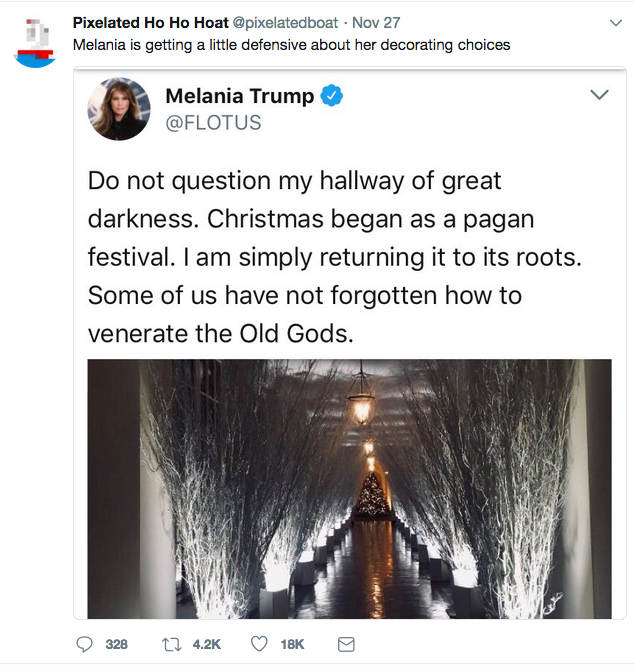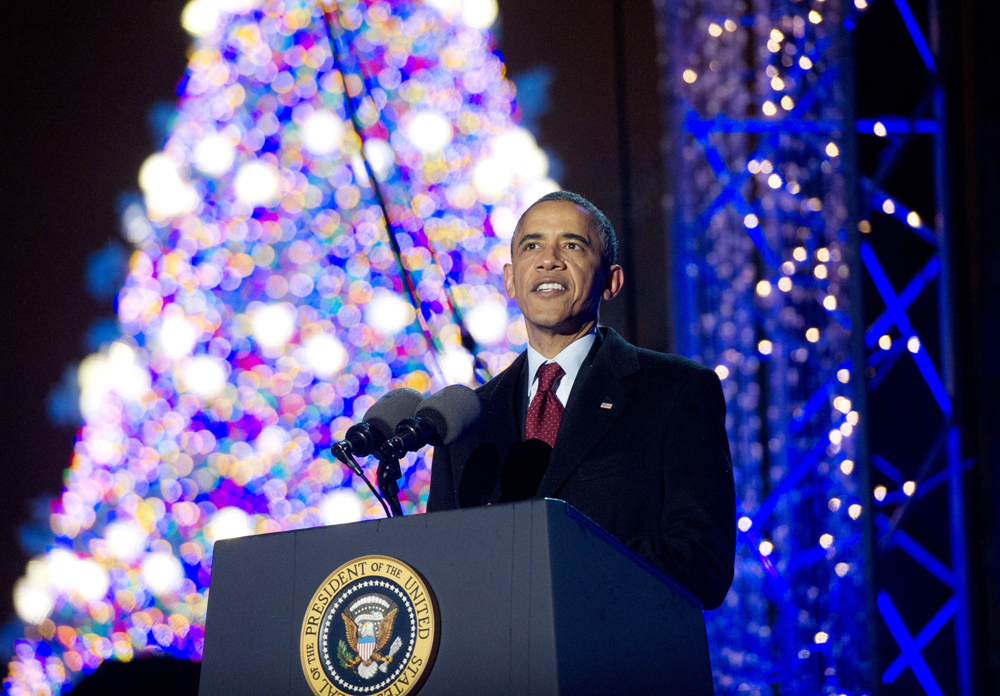A quick look around you will show that if anybody had been trying to have a war on Christmas, it must not have been very successful.

U.S. President Donald Trump has a different take: it’s over, and he won.
“We’re getting near that beautiful Christmas season that people don’t talk about anymore,” Trump thundered in October. “They don’t use the word Christmas because it’s not politically correct. You go to department stores and they’ll say Happy New Year and they’ll say other things; it’ll be red, they’ll have it painted but they don’t say it. Well, guess what? We’re saying Merry Christmas again.”
Trump’s predecessor got a head start on the Merry Christmas business, though:
Former president Barack Obama wished folks a Merry Christmas every year of his administration, starting in 2009, the first Christmas of his presidency, 2010, 2011, 2012, 2013, 2014, 2015 and 2016.
Christmas at the Obama White House did also contain more generic references to ‘the holidays.’
But it turns out that Trump’s does, as well: invitations went out recently inviting people to a holiday reception at the White House. And presidential daughter Ivanka Trump strayed a little off-message this week:
(This story traces the history of the War on Christmas meme, which apparently has a more or less bulletproof resistance to facts — it seems to have been sparked by the U.S.-based conservative Catholic League, and amplified by Bill O’Reilly at Fox starting in 2004.)
“The ‘War on Christmas’ may have become a punch line … but as a rallying cry for cultural conservatives it was effective in convincing them they were under assault by mainstream culture, creating solidarity among Catholics and Protestants and helping to demonize progressives as enemies of religion,” Patricia Miller writes in Religion Dispatches.
This parody account (using a real picture) threw a mischievous curveball into the controversy:

U.S.-based religion writer Jana Riess asks why the tweet was widely taken at face value: “Why were thousands of liberals so willing to believe this outlandish fake tweet? And why were so many conservatives jumping in to defend Melania’s paganism? (Yes, some did. Read the comments.)”
“The depressing reality is that despite the ease of verifying the tweet, liberals jumped on it because they’re living in a time when the president of the United States abuses Twitter every day to shock and defame and mischaracterize. The stage is set; of course we would swallow whole any theatrical display that ensues.”
(A more gentle and thoughtful take on the holiday can be found here and here.)
In fake news news:
- Elizabeth Denham, a Canadian who is now the U.K.’s Information Commissioner, is investigating the role that Victoria, B.C.-based political analytics company Aggregate IQ played in the Brexit referendum campaign last year, the Globe reports. On her blog, Denham says that she is investigating dozens of organizations’ role in the Brexit campaign, some of which “have freely co-operated with us, answered our questions and engaged with the investigation. But, others are making it difficult.”
- And a British parliamentary committee looking at the social platforms’ role in the Brexit campaign is feeling brushed off by Twitter The MP in charge calls the company’s response to recent questions “completely inadequate“. (He’s not happy with Facebook, either.)
- Former Facebook executive Chamath Palihapitiya says he feels “tremendous guilt” about his role in building the platform. “I think we have created tools that are ripping apart the social fabric of how society works.” The Guardian and The Verge report. Palihapitiya’s complete remarks can be seen here.
- In Vice: an account of how a man in London, England made an imaginary restaurant in a shed in his backyard (“The Shed at Dulwich“) the city’s top-rated restaurant on TripAdvisor. The Shed at Dulwich was very exclusive — so exclusive that nobody was ever able to get a reservation. “It has been hailed as an incredible feat. But in an era increasingly influenced by disinformation online, it also has served as another reminder of the ease with which pranksters and other dishonest actors are able to manipulate online platforms,” the Washington Post points out.
- Charlie Warzel’s reporting for BuzzFeed on what I guess we would have to call monetized child exploitation, in some cases child abuse, on YouTube is an unsettling must-read. This week, Warzel and BuzzFeed’s Remy Smidt speak to five creators of videos in the genre, one of whom may have made a million dollars a month. They sound more or less as you would expect. “The algorithm was out of control and irresponsible,” one complains.
- Also at BuzzFeed, Craig Silverman traces how people using porn sites are unwittingly enlisted in a scheme to generate fake traffic for ad networks.
- Russian trolls came out in force to back the doomed U.S. Senate campaign of Roy Moore in Alabama, Mother Jones reports.
- The Atlantic Council’s Digital Forensic Research Lab looks at Russian-linked troll activity linked to the 2014 Scottish independence referendum. As the results were announced, troll accounts claimed the vote had been rigged. DFRLab suspects that a 100,000-signature petition calling for a revote was heavily padded.
- A Wall Street Journal investigation shows that fake online comments on federal regulations are common. The findings parallel data scientist Jeff Kao’s blog post, which we linked to two weeks ago, breaking down in detail how comment fraud actually works.
- The New York Times looks at the parallels between Cold War-era Warsaw Pact disinformation campaigns and the 21st-century version using social media. One example: an elaborate disinformation exercise mounted by the East German intelligence service claiming that AIDS was the product of biological weapons experiments conducted at Fort Detrick, Md. ” … The playbook was simple but effective: Identify internal strife, point to inconsistencies and ambiguities in the news, fill them with meaning and “repeat, repeat, repeat.”
- HuffPo got hold of the style guide for the Daily Stormer, a Nazi site (they have a stylebook.) There are rules for using racial and gender-based slurs, though not the rules you might find elsewhere. “They also take pains to try and not turn off any readers who might be just starting to flirt with white supremacy … it is jarring to read (publisher Andrew) Anglin explained — in such clear-eyed terms, no less — how he actively uses “curiosity or the naughty humor” to draw people in.”
- ‘Fake news,’ used as a term of abuse, has spread from Donald Trump to “many of the world’s autocrats and dictators,” the Times reports. “In countries where press freedom is restricted or under considerable threat — including Russia, China, Turkey, Libya, Poland, Hungary, Thailand, Somalia and others — political leaders have invoked “fake news” as justification for beating back media scrutiny.”




Comments